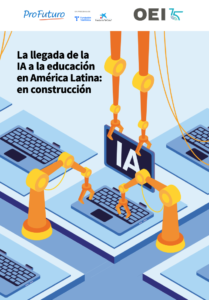A couple of years ago, a machine began to write as if it could think—and left us all astonished: it did so well, meaningfully, and at lightning speed. Although ChatGPT was launched in November 2022, it was by no means the beginning of artificial intelligence. But it did mark a new era in how we perceive its scope.
As with every technological novelty, the reception of generative AI fell between two extreme positions: that of the enthusiasts who saw it as the solution to all of civilisation’s problems, and the doomsayers who viewed it as the root of all evils. In between, Latin American education observes and experiments.
 In this context, the ProFuturo Foundation and the Organisation of Ibero-American States (OEI) have published a joint study, The Arrival of AI in Education in Latin America: Under Construction, which aims to provide a preliminary mapping of the situation of AI in Latin American education: initiatives, progress, risks, opportunities. Nothing definitive. Just an attempt to bring order to the noise.
In this context, the ProFuturo Foundation and the Organisation of Ibero-American States (OEI) have published a joint study, The Arrival of AI in Education in Latin America: Under Construction, which aims to provide a preliminary mapping of the situation of AI in Latin American education: initiatives, progress, risks, opportunities. Nothing definitive. Just an attempt to bring order to the noise.
The report offers a first snapshot of a process that is only just beginning: the slow and uneven arrival of artificial intelligence in Latin American classrooms. Based on its findings, this article explores what is being done, what could be done, which risks must not be ignored, and what decisions will need to be made if the region truly wants to use this technology to transform education.
Private, Varied, and Uneven
Maps matter. Sometimes not because of their precision or detail, but because of what they allow us to imagine. Having a map, even if incomplete, always helps us understand where we’re going. This mapping, which analyses 26 initiatives developed in the region—from the private sector, public policies, and social organisations—shows that there is movement: dispersed, timid, and sometimes improvised, but real.
Most of these proposals come from the private sector. Brazilian, Chilean, Colombian or Argentine startups. Few from the public sector. Fewer still from social organisations. Many focus on language learning—with AI as tutor—or automatic content generation. Others assist teachers in planning or assessment. And a few attempt something more ambitious: data management, dropout prevention, and early warning systems.
The use cases are varied: writing and language-learning assistants, adaptive educational content generators, teacher planning support, rights promotion, or educational management systems using data to prevent school dropouts.
But the most striking feature of the map is its unevenness. Some projects, such as Teachy in Brazil or Platzi in Colombia, show a degree of maturity. Others are just beginning. Overall, the landscape reveals more an intention than a policy: uncoordinated actors, unsustained efforts, and developments still far from rural classrooms or vulnerable contexts.
And yet, something is moving. Just as with the printing press, radio, or educational video in their day, AI is making its way into schools—without anyone fully knowing what for. With more questions than answers. But also with an intuition that, perhaps by necessity, invites hope: this time, it’s not about choosing whether to ride the wave or not, but about learning—sooner rather than later—not to be swept away by it.
What Can AI Bring to Latin American Classrooms?
Enriched and Personalised Content at Low Cost
For decades, the region’s education systems have voiced a near-unanimous complaint: lack of materials, outdated content, disconnect with students’ interests. Generative AI has opened a crack through which something different might emerge.
Projects like Flex-Flix (Argentina), HistorIA (Brazil) or Knotion (Mexico) explore ways to create transversal, interactive content—closer to the language of social media than school textbooks. Videos with AI-generated streamers, adapted stories with historical figures, or systems that turn a song into an English lesson (MusíGlota in Chile).
Elsewhere in the world, the pace is different. Platforms like Diffit, Synthesia or LuzIA already allow educational content to be translated, adapted, rewritten, illustrated and even dramatised in seconds. In theory, this could expand access to quality resources at very low cost. In practice, this potential remains uneven—and currently distant from much of Latin America.
More Efficient Didactic Planning
Teachers spend a great deal of time on invisible tasks: lesson planning, grading, writing reports. Often alone. AI offers, perhaps for the first time, support in these tasks.
In some countries, projects like Ummia (Chile), RDV.IA (Argentina) or Teachy (Brazil) help create custom planning, rubrics, exercises and activities. Some are already integrated with national curricula. They don’t replace teachers, but assist them, save time, and provide ideas.
In the US, models like MagicSchool or EduGPT go even further: they advise, assess, and give feedback. Some even “mark the marker”.
Is this a threat to the teaching profession, or an opportunity to liberate it from bureaucracy? The answer, as always, depends on use, context, training, and intent.
Personalised Digital Tutoring
The great dream—and simultaneously the great limitation—of mass education has always been the same: to treat each student as unique. AI has begun to show that this may, at least partially, be possible.
International models such as Khanmigo (Khan Academy) or Socratic (Google) already interact with students in real time. They identify doubts, adjust levels, suggest pathways. Some can even recognise handwriting.
In Latin America, however, that future is distant. The initiatives found in the study have not yet developed advanced educational chatbots. Once again, the region risks ending up with the beta version.
Automated Assessment and Data Management
Assessment is often synonymous with grading. At best, with measuring. Rarely does it involve understanding. Can AI change that?
The SEA+ platform in Uruguay already offers automated adaptive assessments with instant feedback. In Chile, UPlanner manages data to prevent dropouts. In Argentina, Mendoza’s early warning system detects at-risk trajectories.
Outside the region, the sophistication is different. Tools like Gradescope, Zelexio or EssayGrader already assess essays, competencies, and complex skills. They mark in seconds, with clear criteria—or so they promise.
The risk here is twofold: automating assessment without rethinking its purpose, or delegating pedagogical judgement to an algorithmic black box. As if correction were only about marking errors and not interpreting learning processes.
Risks and Ethical-Pedagogical Dilemmas
Every educational tool, even the noblest, has been used at times to exclude. With AI, that risk is structural.
The most powerful systems require stable connectivity, modern devices, and digital literacy. Exactly what is lacking in the most vulnerable communities in the region. There is, as the study warns, a risk of a “second-class education” enhanced by AI: cheaper, less human, more unequal. The paradox is cruel: those who could benefit the most from well-implemented AI are those least likely to access it.
There are also invisible risks: biased algorithms, loss of privacy, technological dependency. Who trains the AI? With what data? Whose voices are excluded? Automating pedagogical decisions without critical review is a silent form of exclusion.
And then there’s pedagogy. Teaching is not just delivering content. It’s guiding, listening, connecting. If we forget that, we’ll have done very little with a lot. AI can be an ally, but never the centre of the educational act. Education without humanity is simply something else.
The report by ProFuturo and the OEI makes one thing clear: AI is already present in the region, but in a fragmented, unequal way, often without planning or meaningful public participation. Yet there is an opportunity.
The Challenges
Over the past 15 years, the region has made significant efforts in educational digitalisation: distributing computers, creating platforms, training teachers. But when it comes to AI, the gap is stark. Not due to a lack of ideas—the report’s mapping proves that—but due to a familiar combination: material limitations, political discontinuity, lack of planning, and poor coordination among actors.
The first challenge is basic: infrastructure and connectivity. According to the study, many public schools in Latin America lack the technical resources to implement AI solutions. Electricity is unstable in many rural areas. Internet access is patchy. The situation is most critical precisely in the contexts that could benefit most. There is, as the report notes, a paradoxical risk: that AI increases exclusion by being unavailable where it’s most needed.
The second challenge is governance and public policy. The study notes a strong concentration of initiatives in the private sector. Of the 26 mapped, most are developed by startups or tech companies. The public sector appears more timidly, and mostly linked to early warning systems—such as the Ministry of Education of Mendoza (Argentina) or SEA+ in Uruguay. But robust, sustained policies with a regional vision are lacking. AI cannot be integrated into the educational system without a clear, long-term strategy. So far, as the report warns, there is more enthusiasm than planning.
The third major challenge is teacher training. Today, most Latin American teachers have not received specific training in AI. Worse still, many countries lack frameworks defining what teachers should know about these technologies. Some private platforms—like Teachy or RDV.IA—offer tools to plan lessons or generate content. But without a critical foundation, such tools risk becoming templates without pedagogy. Training must go beyond technical skills: it must include computational thinking, algorithmic ethics, and a deep understanding of what it means to educate in times of AI.
There’s also the issue of technological and cultural sovereignty. As the report shows, many tools used in the region originate from foreign headquarters—especially in the US. They’re products designed with other curricula, languages, and pedagogical assumptions. Using them without adaptation is to accept that educational decisions are made elsewhere. Latin America cannot limit itself to importing solutions: it must create its own.
Another under-addressed but fundamental aspect is funding models and cross-sector collaboration. So far, the push for AI in education has come from the private sector. If governments don’t articulate public strategies, there’s a risk that solutions will only be offered where there’s purchasing power—not where the need is greatest. The report also highlights the near-total absence of initiatives from the third sector or non-profit organisations, which have historically played a major role in pedagogical innovation. For now, AI seems like a conversation among experts—not educational communities.
Finally, the most complex challenge: the ethical and social framework. Who designs the algorithms? With what data are they trained? What biases do they reproduce? How is students’ and teachers’ privacy protected? These questions are only beginning to enter public discussion. But they must be central to any educational policy aiming to integrate AI fairly.
Start with the Blueprints
Artificial intelligence will not solve the structural problems of education in Latin America. It will not eliminate inequality, replace teachers, or substitute for the sustained investment that true transformation demands. But it can—if guided wisely—help tackle some of these challenges with new tools.
That requires clear policies, trained teachers, robust infrastructure and, above all, a vision of the future. Not just any future—one that does not delegate to machines what is non-delegable: the task of educating other human beings.
The report by ProFuturo and the OEI makes one thing clear: AI is already present in the region, but in a fragmented, unequal way, often without planning or meaningful public participation. Yet there is an opportunity. The mapped initiatives show that another kind of AI integration is possible: contextual, inclusive, pedagogy-driven rather than technology-driven.
AI is a good opportunity, yes. But also a line that should not be crossed blindly. As the study’s title reminds us, its arrival in Latin American education is still under construction. And when it comes to building, we’d best start with the blueprints.






